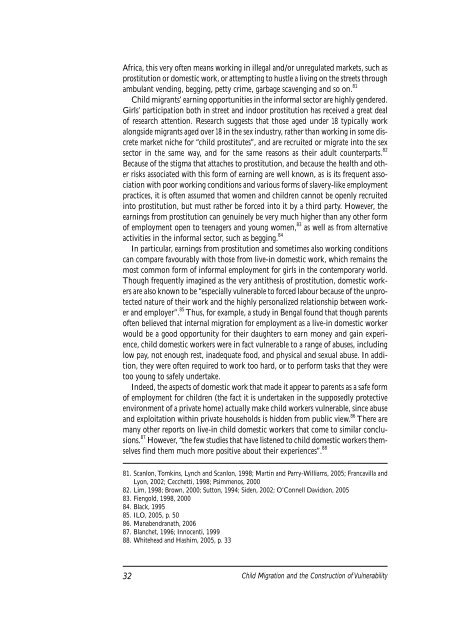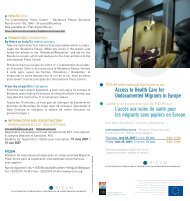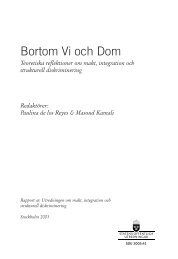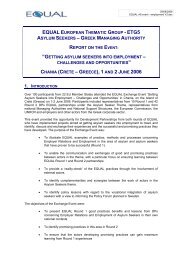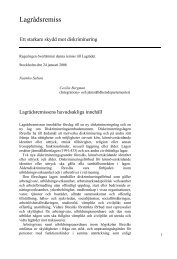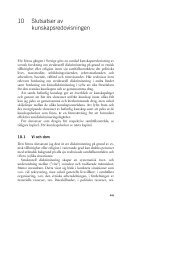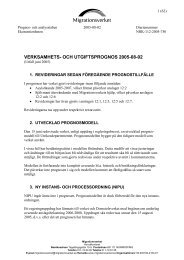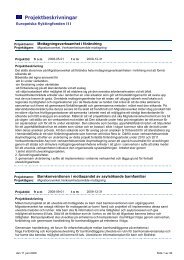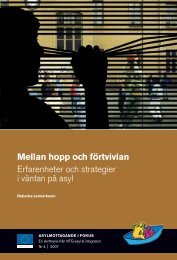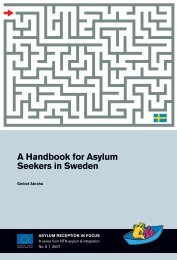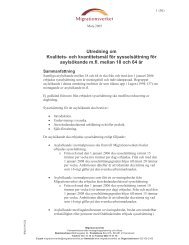and the Construction of Vulnerability - Child Trafficking
and the Construction of Vulnerability - Child Trafficking
and the Construction of Vulnerability - Child Trafficking
Create successful ePaper yourself
Turn your PDF publications into a flip-book with our unique Google optimized e-Paper software.
Africa, this very <strong>of</strong>ten means working in illegal <strong>and</strong>/or unregulated markets, such as<br />
prostitution or domestic work, or attempting to hustle a living on <strong>the</strong> streets through<br />
ambulant vending, begging, petty crime, garbage scavenging <strong>and</strong> so on. 81<br />
<strong>Child</strong> migrants’ earning opportunities in <strong>the</strong> informal sector are highly gendered.<br />
Girls’ participation both in street <strong>and</strong> indoor prostitution has received a great deal<br />
<strong>of</strong> research attention. Research suggests that those aged under 18 typically work<br />
alongside migrants aged over 18 in <strong>the</strong> sex industry, ra<strong>the</strong>r than working in some discrete<br />
market niche for “child prostitutes”, <strong>and</strong> are recruited or migrate into <strong>the</strong> sex<br />
sector in <strong>the</strong> same way, <strong>and</strong> for <strong>the</strong> same reasons as <strong>the</strong>ir adult counterparts. 82<br />
Because <strong>of</strong> <strong>the</strong> stigma that attaches to prostitution, <strong>and</strong> because <strong>the</strong> health <strong>and</strong> o<strong>the</strong>r<br />
risks associated with this form <strong>of</strong> earning are well known, as is its frequent association<br />
with poor working conditions <strong>and</strong> various forms <strong>of</strong> slavery-like employment<br />
practices, it is <strong>of</strong>ten assumed that women <strong>and</strong> children cannot be openly recruited<br />
into prostitution, but must ra<strong>the</strong>r be forced into it by a third party. However, <strong>the</strong><br />
earnings from prostitution can genuinely be very much higher than any o<strong>the</strong>r form<br />
<strong>of</strong> employment open to teenagers <strong>and</strong> young women, 83 as well as from alternative<br />
activities in <strong>the</strong> informal sector, such as begging. 84<br />
In particular, earnings from prostitution <strong>and</strong> sometimes also working conditions<br />
can compare favourably with those from live-in domestic work, which remains <strong>the</strong><br />
most common form <strong>of</strong> informal employment for girls in <strong>the</strong> contemporary world.<br />
Though frequently imagined as <strong>the</strong> very anti<strong>the</strong>sis <strong>of</strong> prostitution, domestic workers<br />
are also known to be “especially vulnerable to forced labour because <strong>of</strong> <strong>the</strong> unprotected<br />
nature <strong>of</strong> <strong>the</strong>ir work <strong>and</strong> <strong>the</strong> highly personalized relationship between worker<br />
<strong>and</strong> employer”. 85 Thus, for example, a study in Bengal found that though parents<br />
<strong>of</strong>ten believed that internal migration for employment as a live-in domestic worker<br />
would be a good opportunity for <strong>the</strong>ir daughters to earn money <strong>and</strong> gain experience,<br />
child domestic workers were in fact vulnerable to a range <strong>of</strong> abuses, including<br />
low pay, not enough rest, inadequate food, <strong>and</strong> physical <strong>and</strong> sexual abuse. In addition,<br />
<strong>the</strong>y were <strong>of</strong>ten required to work too hard, or to perform tasks that <strong>the</strong>y were<br />
too young to safely undertake.<br />
Indeed, <strong>the</strong> aspects <strong>of</strong> domestic work that made it appear to parents as a safe form<br />
<strong>of</strong> employment for children (<strong>the</strong> fact it is undertaken in <strong>the</strong> supposedly protective<br />
environment <strong>of</strong> a private home) actually make child workers vulnerable, since abuse<br />
<strong>and</strong> exploitation within private households is hidden from public view. 86 There are<br />
many o<strong>the</strong>r reports on live-in child domestic workers that come to similar conclusions.<br />
87 However, “<strong>the</strong> few studies that have listened to child domestic workers <strong>the</strong>mselves<br />
find <strong>the</strong>m much more positive about <strong>the</strong>ir experiences”. 88<br />
81. Scanlon, Tomkins, Lynch <strong>and</strong> Scanlon, 1998; Martin <strong>and</strong> Parry-Williams, 2005; Francavilla <strong>and</strong><br />
Lyon, 2002; Cecchetti, 1998; Psimmenos, 2000<br />
82. Lim, 1998; Brown, 2000; Sutton, 1994; Siden, 2002; O’Connell Davidson, 2005<br />
83. Fiengold, 1998, 2000<br />
84. Black, 1995<br />
85. ILO, 2005, p. 50<br />
86. Manabendranath, 2006<br />
87. Blanchet, 1996; Innocenti, 1999<br />
88. Whitehead <strong>and</strong> Hashim, 2005, p. 33<br />
32<br />
<strong>Child</strong> Migration <strong>and</strong> <strong>the</strong> <strong>Construction</strong> <strong>of</strong> <strong>Vulnerability</strong>


